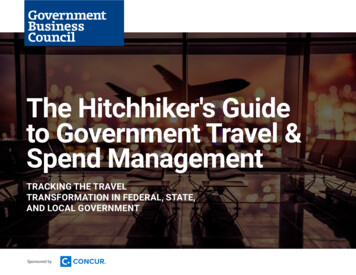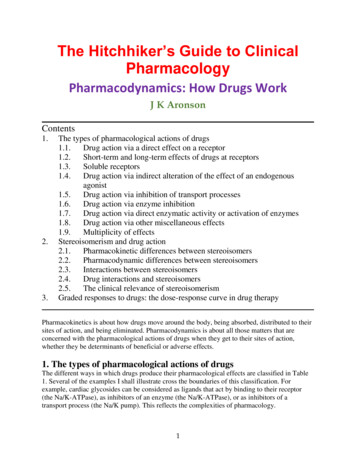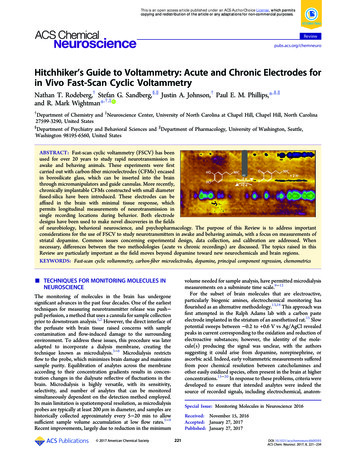
Transcription
The Hitchhiker's Guideto Government Travel &Spend ManagementTRACKING THE TRAVELTRANSFORMATION IN FEDERAL, STATE,AND LOCAL GOVERNMENTSponsored by
IntroductionGovernment travel is on the verge of transformation, and thathas exciting implications for those in public service. Newtechnology and processes are now available that promise toimprove how employees manage travel on the taxpayer's dime,but continued reliance on antiquated equipment, outdated spendmodels, and complicated policy threaten to restrict these capabilities.From challenging long-standing per diem models to reducing thecomplexity of the booking experience, Government Business Councilinvites you to join us in our Digital Briefing Center as we highlight thelatest insights and innovations currently underway to make publicsector travel more convenient, cost-effective, and competitive withthe best travel practices of the twenty first century.Government Business CouncilThe Hitchhiker's Guide to Government Travel & Spend Management Page 2
Briefing #1A Smarter Per DiemEvery day, thousands of public servants travel across the U.S.and around the world to carry out their agency’s mission.Reimbursement of all government business travel — not just theentirety of federal travel but a high proportion of state and localagencies as well — is controlled by government-established perdiem, a system where by employees are given an allowance to coverlodging, meals, and incidental expenses accrued while on the move.1Currently, the General Services Administration (GSA),Department of Defense (DoD), and State Department (State) shareresponsibility in establishing per diem rates and rules for theirseparate spheres of travel — respectively, the Continental UnitedStates (CONUS), non-foreign (e.g., Guam, Hawaii), and international(e.g., Asia, Europe). Despite differences in policy, they generallysubscribe to the same model when funding their travelers: a predefined flat rate, calculated by locality cost and duration of stay.However, as technology has improved government’s ability totrack data, it’s also provided opportunities to refine the per diemplaybook. GSA’s SmartPay program allows agencies to issue travelcharge cards to frequent travelers, which instantly store and reportall transactions while on the go, as well as provides agencies arebate for total sales volume.2 At the same time, the commercialtravel industry has embraced the use of digital e-receipts over paperreceipts, so employees no longer have to worry about substantiatingtheir expenses with hard copy attachments. While governmenthas capitalized on these developments to some degree, it has yet toGovernment Business Councilrealize such benefits across the board. For an illustration of this,look no further than the different approaches it takes to lodgingreimbursement versus meals and incidental expenses (M&IE).Let’s consider lodging first. Over the years, GSA and DoD haveadopted a lodgings-plus methodology, allowing agencies to reimburseemployees for their actual lodging expenses up to aset limit.3,4 This is important because it harnessesthe convenience of digital transactions tosimplify expense management for thetraveler and the agency. For example,say you’re a federal employee andyour business takes you to Arizona.Your lodging per diem limit is 120, but you book a hotel thatcosts 95. Under the lodgings-plusper diem method, you would bereimbursed the actual amountthat your charge card digitallyexpensed when you paid foryour hotel: 95. Conversely, ifyou found a nicer hotel at 145per night, then you would bereimbursed up to the limit of 120and pay the remainder from yourown pocket.The Hitchhiker's Guide to Government Travel & Spend Management Page 3
Meals and incidental expenses (M&IE) are different. Unlikelodging, government M&IE still operates under a fixed per diemrate.5 So if the fixed allowance for M&IE in Memphis is 59 anda traveler spends 42 on meals for a given day, the traveler isreimbursed the fixed amount of 59. The payment amount is greaterthan the actual expense incurred, resulting in a significant portionof federal travel policy that is focused on defining exceptions to theflat M&IE rate. Considering that GSA’s Federal Travel Regulations(FTR) alone contains over 300 pages of such policy—specifying alltypes of rules and regulations for covering certain expenses undercertain circumstances—it’s not at all uncommon for travelers to findthemselves ensnared in a web of complications and compliance.In a pre-digital era, the fixed per diem model actually madesense: by assigning a locality-based fixed rate, it eliminated the needto manually track every individual meal and incidental expenseaccrued over a single trip. However, government’s success with thelodgings-plus model shows that reimbursing employees for actualexpenses isn’t just viable from a user efficiency standpoint; it’s also asignificant cost saver. In the commercial world, where corporationshave largely embraced reimbursing employees for actual M&IE,organizations have seen as much as 35% reduction in their overalltravel spend each year.Government took the right step in moving toward lodgings-plus,but it doesn’t have to stop there. The capabilities now exist to extendthe same approach to meals, promising both a better user experiencefor the traveler and significant cost savings for Uncle Sam.GSA, DoD, and State establish per diem rates and rules for their respectivedomains: Continental United States (GSA), non-foreign territories (DoD), andforeign territories nt Business CouncilThe Hitchhiker's Guide to Government Travel & Spend Management Page 4
Briefing #2Improving Travel ObligationThe late Chuck Berry said it best: “When I look at a contract,I look at the obligation - where, when, how long, thecompensation. If I agree to it, that's the way it is. I have anobligation. They have an obligation.”A central part of the government budgeting process, obligationhappens when an agency sets aside, or “obligates,” a portion of itsfunding each year to reserve those funds for specific use at a later date.6When it comes to travel, for example, agencies traditionally obligateupfront, meaning they approximate the costs a traveler will incur forlodging, airfare, and food prior to the trip actually taking place.This isn’t necessarily a broken system, but it does carry somedownsides. Because the Digital Accountability and TransparencyAct (DATA Act)7 requires agencies to report all their obligations,the authorizing officials in charge of managing these travelarrangements face the arduous task of reconciling theirown agency’s funding requirements with the hundredsof guidelines spelled out in GSA’s Federal TravelRegulations8 or DoD’s Joint Travel Regulations (JTR),9or a myriad of State and Local policy manuals. If thatweren’t enough, they must also be careful not to violatethe Anti-Deficiency Act, which forbids obligatingamounts in excess of available appropriations.10On top of these complications, the amount obligatedis merely a best estimate of what the trip will cost basedon per diem rates, hotel fees, and so on. It’s accurate, butnot exact - and the result is that expense reports rarely evermatch the authorized amount obligated, adding additionalGovernment Business Councilburden to those tasked with managing and accountingfor these differences on the back-end. And in caseswhere scheduled trips don’t occur, agencies also risklosing funding when they neglect to de-obligatethese funds prior to the end of their fiscal year.Recognizing the multiple inefficiencies inthis system, some agencies have adopted a newapproach that is much more to their liking: GSA, along with some agencies in the stateand local space, have taken the lead in simplifying the obligation process by obligating basedon expense report rather than by pre-trip calculation.11 This significantly reduces the complexityof the accounting process and the system resourcesrequired to manage these costs efficiently. The DoD is also conducting an 18-month pilot program of its own,using a simplified rule set taken from the JTR to determine how itmight refine the obligation process.12 The DoD, which spends 8.7billion on travel every year, hopes the pilot may help simplify thedense web of rules currently informing its Defense Travel System(DTS) that processes 3.5 billion of this spend each year.On the whole, most agencies still obligate pre-trip. GSA’s hugesuccess with the actuals model, as well as DoD’s recent foray intosimplifying its rule set, may convince other agencies to do the same,refashioning their own business models in ways that better serve theuser, yield major cost savings, and simplify obligation managementfor future travelers.The Hitchhiker's Guide to Government Travel & Spend Management Page 5
Briefing #3Simplifying The Science Behind ComplianceEven though agencies have made significant strides to update theirtravel policy in a way that is clear and presentable to a modernaudience, there is still a massive amount of travel rules and regulationswhich can overwhelm even the most experienced government traveler.This makes complying to such rules an especially onerous affair. Notsurprisingly, the complexity frequently leads federal travelers down theunfortunate rabbit holes of fraud, waste, and improper paymentswhen they incorrectly submit their travel expenses. Amisunderstanding of policy may result in users expensingpayments over or under the amount they are actuallyowed. In 2016, DoD’s Inspector General cited 458million in total losses due to improper paymentsissued in 2014 alone.13 With over 1600 pages of DoDtravel regulations, the government traveler caneasily find themselves out of compliance and in thehot seat.In other cases, travelers may provide a differenttype of substantiating documentation than whatis required; they may provide documentation thatdoesn’t match the per diem rate; or they may neglect toattach documentation altogether because they didn’t knowit was required. For example, a 2016 report by the GovernmentAccountability Office found that insufficient documentation accountedfor 44 billion of government-wide improper payments made in 2016.14Whereas the commercial world has adopted technology that manages compliance policies and improper payments from the back end, thegovernment largely operates at the other side of the spectrum, enlistingan approving official to check that all requirements and rules are beingfollowed to a tee. This might not have been arduous in the beginning, butsixty years of rule additions and revisions have combined to make it theoverly-complicated situation we see today.Government Business CouncilGovernment might consider following the private sector by investingin solutions and best practices designed to eliminate these upfront entanglements, increase the rate of compliance, and avert millions of dollarsmade in improper payments each year. But instead of taking the expedient route by investing all-in on customized fraud detection equipment,agencies can go a long way in simplifying compliance and mitigatingfraud by adopting a fraud management framework that prioritizes usersfirst. For example, the Office of Management and Budget’s (OMB)Fraud Risk Management Framework, codified in this GAOreport, provides great instruction for how agencies canbetter manage, anticipate, and diagnose the behavioralvariables which so often lead to improper payments.15David Mader, the former OMB controller,says similar efforts are taking shape at the stateand local level too. “We started working back inOctober with the Government Accountability Officeto start thinking about how do we better leveragethe state controllers and state auditor generals inhelping eliminate improper payments,” says Mader.He mentions a recent initiative by the Department ofLabor to develop a cross-state collaborative fraud center,combining technology, business process re-engineering, and dataanalytics to combat fraud through proactive cooperation.16By better understanding the policies and behaviors leading toimproper payments and compliance violations, agencies at all levelsof government will be better equipped to simplify policy in a way thatacknowledges user needs, habits, and preferences. When compliancebecomes convoluted to the point it produces misunderstanding, then iteffectively nullifies its original purpose. Just as technology can play a partin mitigating fraud and streamlining compliance, so can agencies ensurethe processes and behaviors behind such errors are understood andaddressed for the user’s benefit.The Hitchhiker's Guide to Government Travel & Spend Management Page 6
Empower Employees,Improve Spend ManagementBROUGHT TO YOU BYState and local government agencies struggle with many ofthe same issues as the Federal government when it comes totravel and spend management.Whether focused on removing human error, increasing productivity and efficiency, ensuring compliance and simplifying policies,reducing improper payments or fraudulent spending, improvinguser experience and employee retention, or enabling long-term innovation, state and local agencies can manage employee-initiatedspend through a connected cloud, SaaS solution.What does employee-initiated spending really mean? It’s anytransaction an employee is empowered to spend money on thatan agency is obligated to pay. Employee-initiated spend is one ofthe largest transactional aspects of government spending. It canbe notoriously difficult to identify and manage, still plaguing manystate and local agencies.intelligence, providing government agencies with a complete picture. Total visibility enables agencies to better evaluate the cost ofunauthorized purchases, unused discounts, honest errors, wastefulspending, and regulatory compliance to deliver actionable insights.State and local agencies are facing major technology prioritiesin 2017, with cloud technology, modernization, data analytics, andas-a-service offerings topping the most critical items for CIOs atthe state and local levels. Effectively managing employee-initiatedspending stretches across all of these priorities for CIOs and CFOs.Tackling the many challenges that accompany innovation, Concur is helping state and local agencies deliver agility, scalability,efficiency and transparency while simplifying incredibly complextasks so that government employees can focus on achieving coremission objectives.www.concur.comLEARN MOREHow does a cloud, SaaS employee-initiated spending solutionbenefit state and local agencies? It’s about automation and beyond. It’s automation that delivers connected data and operationalGovernment Business CouncilThe Hitchhiker's Guide to Government Travel & Spend Management Page 7
Briefing #4Automate With PurposeAutomation has transformed the travel industry from top tobottom, giving government travelers more control over theirexperiences than ever before. In recent years, public sector agencieshave made significant strides to embrace automation as well. In2016, the White House released a landmark document on artificialintelligence, outlining its vision for automation’s impact on theAmerican economy in the years ahead.17The rise of cloud computing and software-as-a-service (SaaS)models have further facilitated this push towards automation,enabling federal, state, and local agencies to maximize taxpayerdollars, redirect high operational costs to mission services, andharness scalable solutions to satisfy more users.Most importantly is how these benefits come together to giveemployees greater insight, control, and visibility into their spendingdecisions. Let’s break this down: Enhanced user experience: Newtechnology is blurring the linebetween business and personaltravel like never before. In justminutes, a traveler can search anynumber of online travel enginesfor the cheapest flights available,obtaining information that wasonce solely available through atravel agent. Moreover, demandcontinues to grow for technologythat’s accessible, intuitive, andGovernment Business Councildesigned with users in mind. That means user interfaces free ofclutter, faster booking times, multi-channel touchpoints acrossdifferent devices, and more access to employee-initiated spendtools. Whether it’s arranging a travel experience from pre-trip tofinal expense, or simply scanning vast troves of data to optimize mission outcomes, automation can eliminate the labor andattention typically required to manage spending data, giving employees the insights and control they desire over their purchasedecisions. Smarter resource allocation andmanagement: Automation frees agencies to pursue their mission more efficiently. Instead of devoting resourcesto manual submission, sharing, andverification of travel data, agenciescan automate their workflow systemssuch that any pertinent documentscan be routed immediately to therelevant authorizing personnel, eliminating unnecessary overhead. This means less time spent on planning business travel andexpense reports, and fewer personnel required to ensure suchoperations run efficiently. For local governments like OaklandCounty, Michigan facing a shrinking workforce, automation isenabling them to maintain productivity and allocate personnelmore resourcefully.18 On top of all of this, automation can vastlyimprove audit operations, adding precision and robust featureswhich help minimize the human risk associated with improperexpenses and lost receipts.The Hitchhiker's Guide to Government Travel & Spend Management Page 8
Significant cost avoidance: Whereas traditional over-the-phonebooking with a human agent can cost anywhere from 17 to 25per transaction, the automated self-service transaction costs afraction of that amount ( 2 - 6). At the same time, automationcan enable agencies to redirect funds toward citizen services byenhancing data visibility and improving compliance with traveland spend policies. That leads to smarter decisions, more efficient operations, major cost avoidance, and happier taxpayersAutomation delivers a huge boon for government travel. AsMassachusetts demonstrates, streamlining workflow and policies tosupport automation is essential for reaping the full benefits.With such benefits to be had, it’s easy to jump on board theautomation train. However, in doing so government agencies shouldbe careful not to propagate “innovacracy,” what MassachusettsComptroller Tom Shack describes as government’s tendency tosuperimpose bureaucratic frameworks on innovative ideas, therebyrestricting their full creative potential. Although agencies have triedto embrace automated systems, they often simultaneously manualizetasks these systems were designed to accomplish on their own. Theyalso tend to focus on highly customized commercial solutions, oftenwith the result of recreating the legacy solutions these agencies weretrying to replace.We overcame innovacracy byembracing true innovation,capturing ROI in small butescalating wins.TOM SHACK, COMPTROLLER, STATE OF MASSACHUSETTSShack speaks from experience. Under conventional processes,it took 7 years and 1.4 million for Massachusetts to procure acustomized data-sharing system. By comparison, after moving toa support model featuring incremental, automated updates andconfigurable, single-instance solutions, the state government wasable to procure a similar data-sharing system for less than 200,000and all in the span of a few weeks.19 From ideation to launch, theproject was completed in under 7 months.Government Business CouncilThe Hitchhiker's Guide to Government Travel & Spend Management Page 9
Briefing #5Make Way For The Mobile MindsetAll that automation’s had a dizzying effect on travelers. It’s safeto say most of us expect the best user experience wherever,whenever, and on whatever devices we happen to have handy. Whenthe ability to access, inquire, review, or edit any part of the travelexperience breaks down, we tend to unravel a bit ourselves.interface.”26 Seen in this light, policy manuals like the DoD’s JointTravel Regulations can appear downright masochistic: 1,396 pagesof rules, 200 pages of appendices, and a bevy of conflicting policiesand rule exceptions. In other words, not the ideal ingredients for asimplified, mobile user experience.While we could all learn a little from comedian Louis C.K., there’sno escaping the mobile mindset of travelers.20 An astounding 40%to 50% of all travel transactions are now processed through mobiledevices.21 Like anyone else, government employees expect theirpersonal smartphones and tablets to be able to relay the latesttravel information when they need it, especially while onthe move. These expectations dramatically elevate theimportance of the user interface, not only in terms of thetechnological facade but also in the broader processesand interactions facilitating the travel experience fromstart to finish.Consequently, it’s not uncommon for many employees to carrytwo mobile devices — one for work and one for personal use.Government agencies and contractors that find themselves in thesesituations then have to consider how their policies should approachaccessibility to mobile applications outside of or in parallel tocompany-issued devices. While states operate on a different scalethan the DoD, many also face the challenge of translating vast rulesets, travel policies, and federally imposed regulations into a secureuser experience that makes sense for the standard traveler.In recent years, the U.S. Digital Service and 18Fhave seized on this mission by working to simplify publicaccess to some of government’s most essential services,including travel,22 healthcare,23 college admissions,24 andprocessing of visa applications.25 This simplification largelydepends on the availability of a mobile channel. Implementingmobile solutions into government travel has proven morecomplicated than one might expect.Much of these complications are a byproduct of prevailing travelpolicy at federal, state, and local levels of government. It’s a wellknown axiom in the design world that “the best user interface is noGovernment Business CouncilGovernment is now taking steps to simplify policy and betterserve the traveler’s mobile experience. For example, the Stateof Georgia recently unveiled its TeamWorks Travel & ExpenseSolution, which allows employees to receive reimbursementsfaster, review and approve reports on-the-go, and share travelplans and assignments easily across any device with members oftheir team.27 The State of Indiana has also deployed a mobile devicemanagement solution, providing an enterprise-wide app store forits employees to submit records, access email, and securely operatevia any available VPN or wireless profile.28 According to DewandNeely, Director of Desktop Services at Indiana’s Office of Technology,the new capabilities have “enabled self service” to a much greaterdegree, likely contributing to Indiana’s recent #1 ranking in U.S.The Hitchhiker's Guide to Government Travel & Spend Management Page 10
News and World Report’s list of most effective state governments.29By implementing mobile travel and spend management solutions,states like Indiana and Georgia offer a viable blueprint for how toequip employees with the user-friendly tools they need to maintaincompliance across their agencies.The federal government is moving to simplify travel as well. Incollaboration with USDS, the Defense Travel Management Office (DTMO)is rewriting a simplified version of its JTR and fielding a modernizedDefense Travel System (DTS), this time with users in mind.30 Throughthis simplification, DTS aims to improve accessibility for governmenttravelers, allowing them to submit expenses on the fly, capture digitalreceipts, enhance workflow management, and reduce manual entryof data whenever possible. Understanding the continuous advanceof technology and need for mobile accessibility, modernizing a legacysystem like DTS has to be weighed against leveraging commercial offthe-shelf solutions to achieve better processes, better data, and bettercontrols. What some leaders in this space are finding is that usingsoftware-as-a-service (SaaS) solutions to manage government travel andspend enables a better, more mobile user experience and continuousinnovation for government agencies.31The Modernizing Government Travel Act of 2016 looks tobuild on these efforts.32 By allowing agencies to reimburse travelbooked through solutions offering a mobile platform, the law aimsto “expand and enhance available transportation choices, bettermanage demand for transportation services, and provide alternativesto driving alone.” Given the bill’s bipartisan backing, it’s a greatexample of how industry experts can help government agenciesoptimize their mobile capabilities for a better user experience.Government Business CouncilIf you can imagine 50 years ofpeople writing for themselves,not necessarily writing forthe users, I think that putsperspective on the challengewe have. DTS is really not a badsystem, but my experience withautomated systems is that thesystems do what the businessprocess codes tell them to do.So if you have complex policies,what does that tell you about theprogramming language withinthe system?” [We need to be]willing to write the policy for theusers and not for ourselves.WILLIAM MANSELL, DIRECTOR, DEFENSE TRAVEL MANAGEMENT OFFICEThe Hitchhiker's Guide to Government Travel & Spend Management Page 11
Briefing #6From Insights to ActionIf there’s anything tying all these innovations together underone roof, it’s data. Rewriting policy, automating technology, andimproving mobile access for users are all necessary steps forgovernment agencies, but such initiatives will only go so far if dataisn’t driving the core decision-making process.For example, new technology may reveal that employees aremore likely to book flights on theirphone while preferring to rent carsin-person. That’s insightful, but itdoesn’t make it necessarily valuablejust yet. The critical step is havingboth technology and processes inplace that (1) can diagnose whythis is a common practice amongusers, and (2) inform decisionmakers how to capitalize on suchknowledge. While many agencieshave onboarded new technology thatcan optimize processes and improvethe user experience, translating datainto actionable intelligence is still awork in progress for most.Through analysis of employee spend data, agencies can delveinto traveler habits and trends, gain situational awareness ofhow policies impact such habits, and make the smartest use ofavailable inventory. Mining such insights can in turn lead to bettertravel policy, more efficient allocation of resources, and improvedGovernment Business Councilunderstanding of the optimal workflow processes needed forsuccessful automation.Likewise, careful analysis of data can reveal the policymisunderstandings, technical hiccups, and user errors thatfrequently contribute to improper payments or complianceviolations. It also frees agencies to answer questions beyond thefundamental accounting process,encouraging development ofinitiatives that please users andprovide financial transparency andaccountability to existing operations.For example, the City of Austin’sTransportation Department hasadopted an open data mindset,providing its citizens access toinformation on traffic statistics,maps, road construction, andother regularly updated datasets.33Likewise, as part of its open datacampaign, the State of Maryland nowoffers its government employeesa user-friendly tutorial for datasubmission and expense tracking via the agency’s data portal.34Government agencies and contractors are starting to see howdata can be harnessed to improve operations on multiple fronts: first,by providing citizens a gateway into government programs and civicdata; and second, by giving employees a set of tools to manage theirThe Hitchhiker's Guide to Government Travel & Spend Management Page 12
spend responsibly and conveniently. Even so, the majority of stateand local agencies continue to operate with an incomplete pictureof their spend management data, making decisions based on staticpen-and-paper assessments rather than from automation and robustanalytics systems.The federal government has similarly acknowledged the valueof data to improve travel spend management and compliance, butlike their state and local government peers, many are still early in thejourney when it comes to harnessing data effectively. A 2016 reportby GAO found data limitations in effect at federal agencies with thehighest travel spend per year.35 According to the report, agencies werehindered by a lack of standardized reporting practices that disabledsharing and evaluation of travel spend data among departments. Otheragencies GAO profiled lacked the data capabilities and tools needed toquantify their cost savings in the first place.Meanwhile, a few other agencies have won praise for usingdata to revamp their spend management processes. By requiringusers to book online flights for the lowest airfare, the JusticeDepartment was able to realize more than 9.2 million in savings.36The Defense Department also reported gains by implementing aper diem reduction for travel lasting over 30 days, avoiding 56million in costs.37 And according to GAO’s recent report, GSA isdeveloping a shared services model that will allow agencies to sharedata, resources, and services with each other in order to reduceadministrative costs and better facilitate data-driven decisions.Government Business CouncilBut steps like these are just the tip of the iceberg. A wealthof potential innovations lie around the corner for federal, state,and local governments willing to take data seriously. Whether it’scrowdsourcing the public for new solutions, surveying traffic datato propose alternate, safer routes, or consolidating regional healthdata to identify the leading causes o
collaboration with USDS, the Defense Travel Management Office (DTMO) is rewriting a simplified version of its JTR and fielding a modernized Defense Travel System (DTS), this time with users in mind.30 Through this simplification, DTS aims to improve accessibility for government travelers, allowing them to submit expenses on the fly, capture digital











